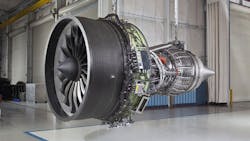The National Transportation Safety Board is urging the Federal Aviation Administration (FAA) to require frequent inspections of two General Electric aircraft engines, the GEnx-1B and GEnx-2B, following the discovery of cracks in engine shafts on two Boeing 787 Dreamliners, and possibly on a Boeing 747-8 cargo plane.
GE Aviation produces the GEnx dual-rotor turbofan engine for the Boeing 787 and 747-8. It is the most recent engine introduced by GE, appearing commercially in 2006. It is one engine option for Boeing’s Dreamliner; another choice is the Rolls-Royce Plc Trent 1000.
The current concern stems from the discovery of debris from one of the engines during a July preflight test of a Boeing Dreamliner. Reportedly, another similar crack was found late in August on an engine installed in another 787, also not yet in service. NTSB cited another crack found on a larger model GEnx engine installed on a cargo plane that lost power and was forced to abort a takeoff, suggesting the same problem discovered on the Dreamliners
Investigation of the incidents led NTSB to conclude that the fan midshafts on the GEnx engines had fractured or cracked at the forward end of the shaft, where a retaining nut is installed.
Reportedly, GE had recommended a more environmentally friendly coating for the midshaft, one containing less lead than had been contained in the previous coating. The manufacturer now concludes the new coating traps moisture on the shafts and weakens them. Now, it intends to resume using use the previous formulation to provide a stronger protective coating on engines still being manufactured.
NTSB’s statement is directed at FAA to address GEnx engines now in service. The panel explained that GE developed a field ultrasonic inspection method to inspect the fan midshaft in the area where the fracture and crack occurred. That inspection can be accomplished with the engine still installed on the airplane. It noted that all in-service and spare GEnx-1B engines have been inspected, and all GEnx-2B engines on passenger airplanes have been inspected.
However, NTSB emphasized there are approximately 43 GEnx-2B engines on 747-8F cargo airplanes that have not yet been inspected, and that these engines may be susceptible to a fan midshaft failure.
Now, NTSB is recommending that FAA issue an “airworthiness directive” that will require immediate ultrasonic inspection of the fan midshaft in all GEnx-1B and -2B engines that have not undergone inspection, before any further take-offs.
Also, the Board is asking FAA to require repetitive inspections of the fan midshaft “at a sufficiently short interval that would permit multiple inspections and detection of a crack” before it may reach critical length, causing the fan midshaft to fracture.
The engine manufacturer had hoped to address the safety concerns through voluntary inspections, but the recommendation from NTSB will ensure a more public airing of the matter.
"The parties to our investigation — the FAA, GE, and Boeing — have taken many important steps and additional efforts are in progress to ensure that the fleet is inspected properly," said NTSB chairman Deborah A.P. Hersman. "We are issuing this recommendation today because of the potential for multiple engine failures on a single aircraft and the urgent need for the FAA to act immediately."
About the Author
Robert Brooks
Content Director
Robert Brooks has been a business-to-business reporter, writer, editor, and columnist for more than 20 years, specializing in the primary metal and basic manufacturing industries.
